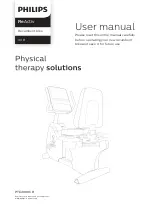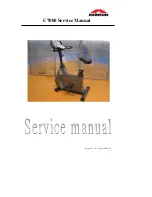
1 5
English
warm up and cool down phases, but towards the end
of the exercise phase you should increase resistance
making your legs work harder. You will have to reduce
your speed to keep your heart rate in the target zone.
Weight loss
The important factor here is the amount of effort you
put in. The harder and longer you work the more
calories you will burn. Effectively this is the same as if
you were training to improve your fitness, the difference
is the goal.
Heart rate
Pulse rate measurement
(hand pulse sensors)
The pulse rate is measured by sensors in the handlebars
when the user is touching both sensors at the same
time. Accurate pulse measurement requires that the
skin is slightly moist and constantly touching the hand
pulse sensors. If the skin is too dry or too moist, the
pulse rate measurement will become less accurate.
NOTE
• Do not use the hand pulse sensors in
combination with a heart rate chest belt.
• If you set a heart rate limit for your workout, an
Maximum heart rate
(during training)
The maximum heart rate is the highest heart rate a
person can safely achieve through exercise stress. The
following formula is used to calculate the average
maximum heart rate: 220 - AGE. The maximum heart
rate varies from person to person.
WARNING
• Make sure that you do not exceed your
maximum heart rate during your workout. If you
belong to a risk group, consult a physician.
Beginner
50-60% of maximum heart rate
Suitable for beginners, weight-watchers, convalescents
and persons who have not exercised for a long time.
Exercise at least three times a week, 30 minutes at a
time.
Advanced
60-70% of maximum heart rate
Suitable for persons who want to improve and maintain
fitness. Exercise at least three times a week, 30 minutes
at a time.
Expert
70-80% of maximum heart rate
Suitable for the fittest of persons who are used to long-
endurance workouts.
Use
Adjusting the support feet
The equipment is equipped with 2 support feet. If
the equipment is not stable, the support feet can be
adjusted.
-
Turn the support feet as required to put the
equipment in a stable position.
Adjusting the vertical seat position
The vertical seat position can be adjusted by setting the
seat tube to the required position. With the leg almost
straight, the arch of the foot must touch the pedal at its
lowermost point.
-
Loosen the seat tube adjustment knob.
-
Move the seat tube to the required position.
-
Tighten the seat tube adjustment knob.
Adjusting resistance
To increase or decrease resistance, turn the adjustment
knob at the top of the handlebar support tube
-
Clockwise (+ direction) to increase resistance.
-
Counter-clockwise (- direction) to decrease
resistance.
The scale above the knob (1-8) helps you find and reset
a suitable resistance.
Replacing the batteries
The console is equipped with 2 AA batteries at the rear
of the console.
-
Remove the cover.
-
Remove the old batteries.
-
Insert the new batteries. Make sure that batteries
match the (+) and (-) polarity markings.
-
Mount the cover.
Summary of Contents for FitCycle 30
Page 2: ......
Page 3: ...3 FitCycle 30 A...
Page 4: ...4 FitCycle 30 B i...
Page 5: ...5 FitCycle 30 C 100 cm 100 cm 100 cm 100 cm D 0...
Page 6: ...6 FitCycle 30 D 1 8 8 7 7...
Page 7: ...7 FitCycle 30 D 2A A C B...
Page 8: ...8 FitCycle 30 D 2B...
Page 9: ...9 FitCycle 30 D 3A...
Page 10: ...1 0 FitCycle 30 D 3B 32 33...
Page 11: ...1 1 FitCycle 30 D 4...
Page 12: ...1 2 FitCycle 30 D 5...
Page 44: ......
Page 45: ......
Page 46: ......
Page 47: ......
















































